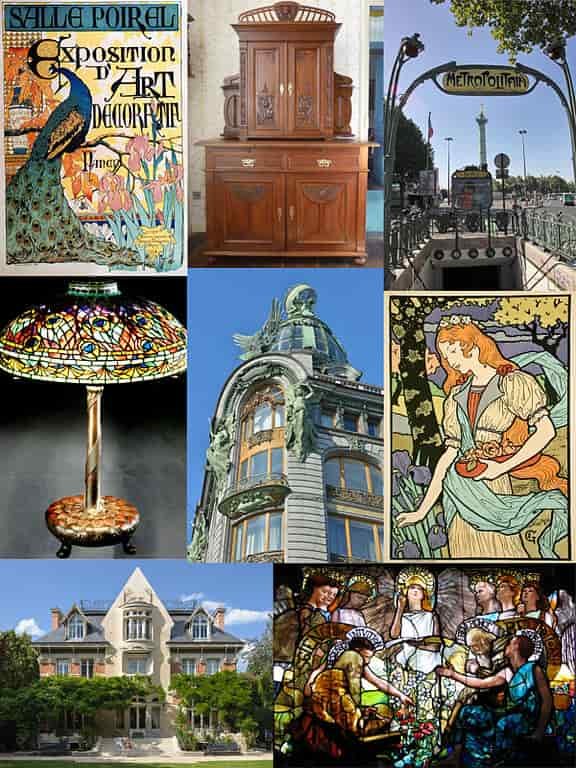Art Nouveau Style
This artistic movement beginning around 1890 and ending around 1914. Art Nouveau was born during the industrial revolution. It is characterized with the flower, the woman, the curve with a rich and highly charged style.
As its name suggests, breaks moorings with the past. The end of the 19th century had seen the flourishing of the Napoleon III style, which had only been a simple adaptation of all previous eras. In other words, no modernism, in the sense of novelty, marked the end of this era.
This is the beginning of a big change:
And suddenly, life changes: industry is born on a large scale (2nd industrial revolution); we discover at the same time aviation, the telephone, and the use of electricity.
Technical progress, accompanied by four decades of peace, causes great optimism and recklessness about the future.
That’s not all.
The social condition also underwent profound changes, men, from the people, began to assert themselves and impose themselves in society. It is therefore normal that these upheavals be accompanied by a renewal of artists, a change of expression.
These are the beginnings of Art Nouveau, or more precisely of Modern Style.
Indeed, the expression “Art Nouveau” was used for the first time by Edmond Picard, in 1894, in the Belgian magazine L’Art moderne to describe the work of the Belgian artist Henry van de Velde.
We then speak of the 1900 style.
This architectural style is defined by a flexibility of lines, a certain sensitivity that enters into everyday life. There is a novelty, a modernism, color, and even an extravagance for the time.
This is expressed in all artistic fields, including jewelry, furniture, works of art, and even architecture. This style occupies all the space available to create a truly personal universe. It is total, to create a link between art and life.
In short, nothing is like the past, and nothing will be like the future.

Art Nouveau and Modern Style touches all of Europe
This new aesthetic is beginning to take hold in Belgium, where Brussels is a hotspot. The formal principles of an Art Nouveau architecture are defined there.
Gradually, the movement, which took on different names depending on the country, took hold throughout Europe, and even in the United States. It’s sudden, and very fast!
Liberty, Jugendstil, Secession?
Does that tell you something? Everywhere, and at the same time, the style begins to hatch, to affect only a part of the population (we will see why later).
Straight lines gradually turn into curves.
In Italy, the movement takes the name of Liberty, in Germany, it will be Jugendstil, and finally, the Secession for Vienna.

Modern Style and Art Nouveau, what are the differences?
The Modern style for the end of the century!
The main difference lies in the era, the Modern Style is the precursor of Art Nouveau, which shows the role played by England. This term was used by journalists to describe architecture and decoration at the end of the century.
A big upheaval:
There was such a change in the design of furniture, objects, jewelry, ornamentation that one can be surprised to have witnessed such a rapid craze, and which to be satisfied, required significant expenditure. .
The Modern Style was more a fashion of wealthy people; which did not touch the deepest layers of society, because everything had to be changed to “be fashionable”.
We can see the Modern Style as the ultimate bulwark, the ultimate defense against what will inevitably result from industrialization, mass production.
The most important:
We must not forget that the resulting Art Nouveau was intended to be an Art for all, made accessible through mass production. Unlike the Modern Style, Art Nouveau will affect the whole of society.
Here is a first element of differentiation.

Art Nouveau from 1900
For many of us, 1900 represents a certain image of a bygone era, even if some vestiges are still present. That of a sinuous metro entrance like the Metropolitain, a floral setting where water lilies and umbels meet…
But above all, this architectural style is the spearhead of artistic craftsmanship, eager to highlight the know-how of artists, craftsmen and workers! After this Art Nouveau style died… the Art Deco Style was born as a reaction to the artistic excesses of the Art Nouveau style.
Sources: PinterPandai, The Art Story, Europeana



